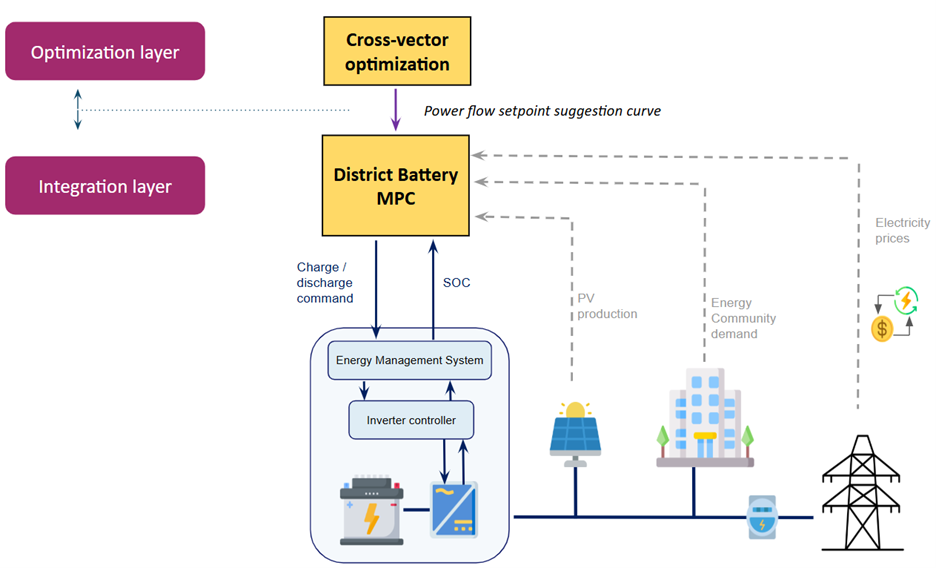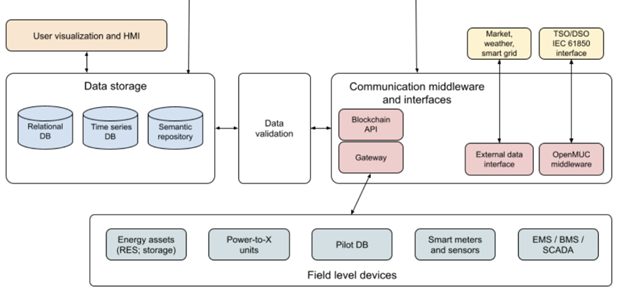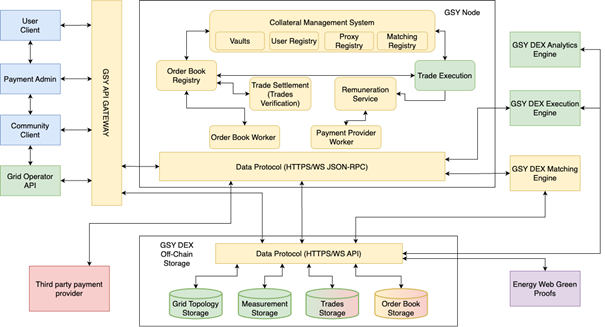Modular tools and services
developed within FEDECOM
FEDECOM has developed a modular suite of technical tools and services to facilitate and optimize participation of energy communities in electricity and flexibility markets. These solutions, in the form of backend software code and accompanying documentation, span from demand and distributed production forecasting to blockchain-based trading, with performance-based remuneration and accompanying analytics. Together, they enable diverse, complementary future commercial applications for energy communities to interact securely and transparently within federated systems that allow for trading among diverse energy assets and communities. FEDECOM will also develop user interfaces for energy data monitoring and for select services such as forecasting and matching. This page provides an overview of innovative developments delivered by FEDECOM technical project partners, while accounting for the project’s regulatory and social analysis, and all converging toward replicable, open-source energy community solutions.
Decentralised Energy Exchange
At the heart of FEDECOM’s market logic is the GSY DEX (Grid Singularity’s decentralised energy exchange). Built on blockchain, it enables communities to trade electricity and flexibility using peer-to-peer or peer-to-market mechanisms, both for trading within a single community and among two or more communities, while also allowing grid operators to procure energy and flexibility across communities. It separates matching and settlement processes for efficiency and complex market management, maintaining topology-aware data communication. The DEX integrates with other FEDECOM-developed components, leveraging forecasting in the matching process, and facilitating performance verification and remuneration. The exchange layer operates independently but relies on forecasting and interoperable data access and management service, allowing for dynamic market interactions based on real-world flexibility potential. Verification is provided by the Analytics Engine, which computes key performance indicators such as self-consumption, self-sufficiency, grid imports/exports, and delivery accuracy. These KPIs are exposed via secure APIs and are used by the remuneration logic to trigger automated settlement. The diagram below illustrates the DEX architecture, including its six key system components (GSY Node and GSY DEX Off-Chain Storage, Matching Engine, Execution Engine, Analytics Engine and API Gateway, and the interaction with other services such as payments and guarantees of origin. The development of the GSY DEX v.1 in the framework of the FEDECOM project is fully documented and available in the public GSY wiki.
Performance-Based Remuneration
FEDECOM supports several remuneration models to adapt to different flexibility market contexts. These include schemes that reward overdelivery (positive adjustment), penalise shortfalls (piecewise penalties), and hybrid approaches that combine both incentives and disincentives. In each case, performance indicators such as self-consumption, forecast accuracy, and flexibility contribution are used alongside configurable tolerance bands to determine compensation. This logic is executed through smart contracts deployed on the blockchain layer, ensuring that settlement is secure, auditable, and automated.
Forecasting Services and Model Predictive Control Systems
To support market participation and delivery verification, FEDECOM incorporates a forecasting suite to generate real-time and predictive insights into flexibility potential at both the asset and community levels. Forecasts inform trading strategies, support matching decisions, and enable reliable comparisons between committed and delivered flexibility. The diagram below highlights the forecasting layer, which is part of FEDECOM’s broader energy asset control and optimisation environment. In addition to serving the DEX as described above, the forecasting services also support Model Predictive Control (MPC) systems.
FEDECOM uses advanced MPC systems to optimise the behaviour of flexible assets, particularly community batteries. These controllers rely on forecasting inputs- such as solar generation, energy demand, and price signals -to dynamically adjust charging and discharging based on system constraints and predicted conditions. The MPC plans are then compared to actual battery performance to assess flexibility delivery, with smart contracts automatically calculating remuneration based on how closely the system followed the optimised strategy. The illustration below shows how this process integrates forecasting, battery control, community-level inputs, and energy market dynamics. This integrated approach guarantees that compensation reflects real, measurable contributions to energy system stability, creating fair incentives for long-term participation in energy markets. Similarly, the approach is applied to the thermal vector instead of the electrical vector. Thermal storage or the inertia of the buildings themselves provide the equivalent flexibility to batteries in electric MPCs. In addition, assets that use different energy carriers or are modular will also allow the operation and Demand Response to be optimised.

Data Interoperability and Developer Resources
FEDECOM’s interoperability layer manages secure acquisition and exchange of data between field devices, optimisation services, and external actors. Semantic data handling, standardised APIs, and identity-based access ensure that energy data flows are reliable, privacy-compliant, and machine-readable. These services are critical for connecting forecasting results, performance KPIs, and user interfaces to the overall platform logic.

All components developed within FEDECOM follow a modular architecture, allowing communities, aggregators, and grid operators to connect their systems securely. Separate visualisation tools are being developed for both grid operators and community users, offering role-specific insights into flexibility performance and system coordination. An API Gateway acts as a single point of entry to standardize data access and apply role-based permissions, exposing key endpoints for forecasting, trading, and KPI reporting. Interfacing with external assets and data systems (such as energy and building management systems, smart meters, or grid operators) is made possible via RESTful APIs, identity verification protocols, and semantic interoperability layers. The middleware created for this task is based on the versatile and easy to use OpenMUC framework.
The semantic interoperability layer is orchestrated by an ontology, which has been modelled according to the data needs of the technical stakeholders and reusing terms from well-known ontologies such as SAREF, Brick or BOT. It consists of a characterization layer, in which all pilots, sites and assets (along their characteristics) are depicted, and a measurements layer, which includes all the necessary information to obtain any measurement from its corresponding platform. The elements in this last layer are linked to their corresponding assets in the characterization part, so a full conceptual representation of each pilot is included as part of the knowledge in the ontology instantiation.
Replication Self-Assessment Tool
To support organisations interested in adopting FEDECOM components, this self-assessment tool helps identify which replication pathway (Minimal, Intermediate, or Full) is best suited to your needs and capabilities. Based on your selected role and how you answer the short questionnaire, you’ll receive a pathway recommendation based on your readiness level – with no data stored or shared.
FEDECOM Replication Playbook
Online Assessment Tool
Choose Your Profile
Select the replicator profile that best describes your organization to begin the assessment.
Site Owner / Energy Community
Organizations that own or manage physical infrastructure like campuses, districts, or housing cooperatives.
Technical Integrator / Solution Provider
Engineering firms, consultants, or IT teams responsible for implementing FEDECOM solutions.
Aggregator / Market Operator
Actors enabling multi-site energy coordination, demand aggregation, or decentralised trading.
Public Sector / Policy Enabler
Municipalities, regulators, or public authorities involved in enabling, funding, or approving replication.
Replication Readiness Assessment
Instructions
For each question, choose the answer that best fits your current situation. Your score will determine a recommended replication pathway.
Your Recommended Pathway is:
For questions or collaborations, please contact zia.lennard@r2msolution.com



